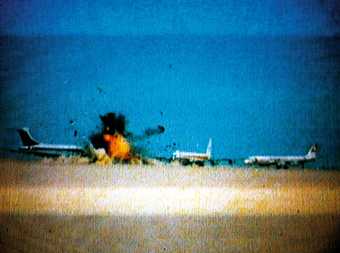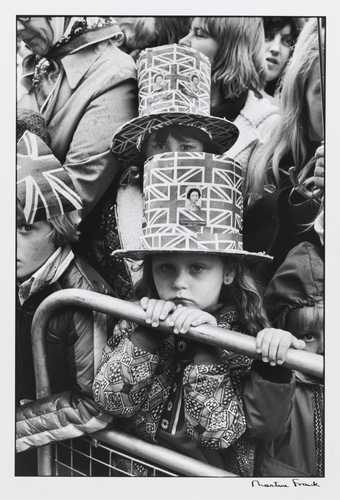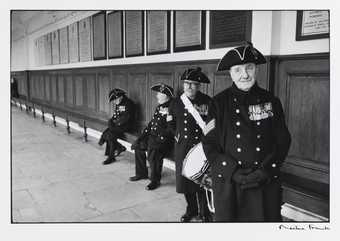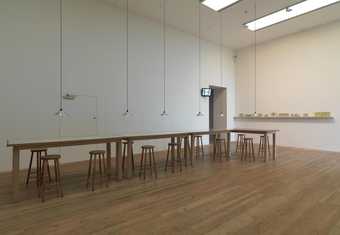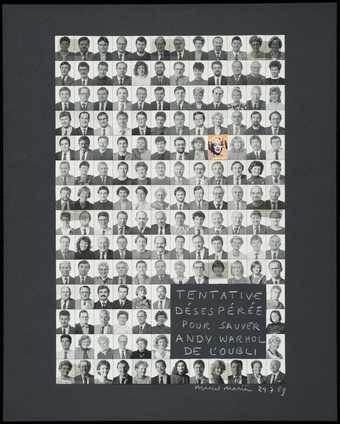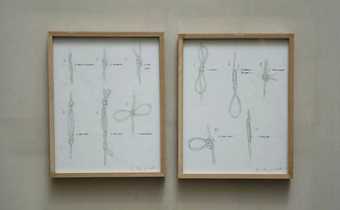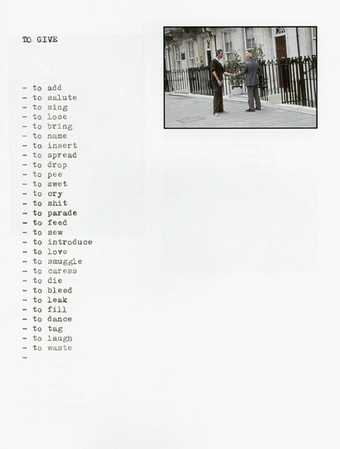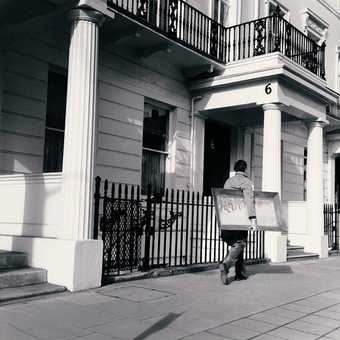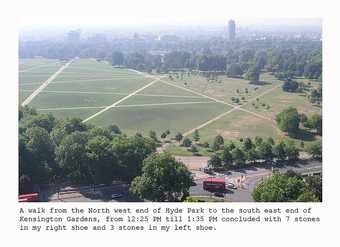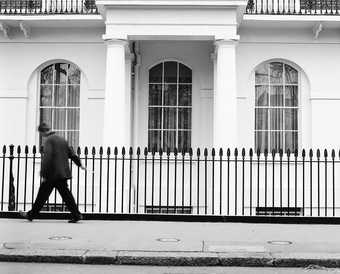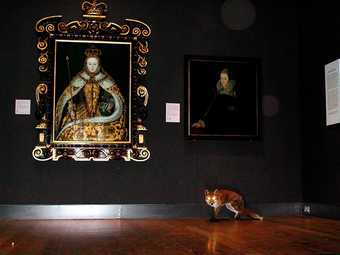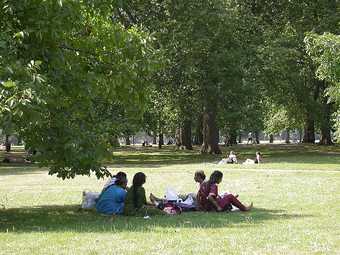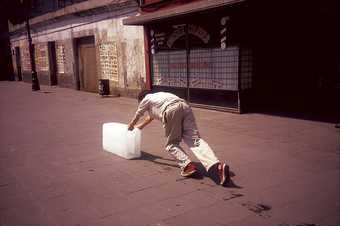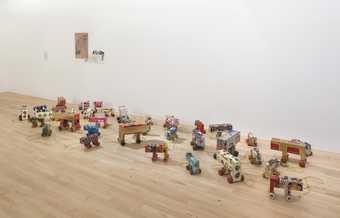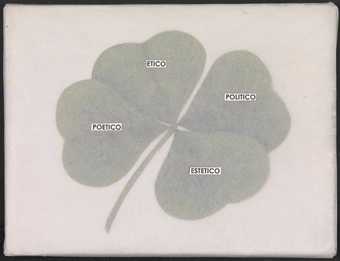
Not on display
- Artist
- Francis Alÿs born 1959
- Medium
- Video, printed papers, drawings and 64 tin soldiers
- Dimensions
- Duration: 27 min
overall display dimensions variable - Collection
- Tate
- Acquisition
- Presented by Tate Patrons 2006. The Artangel Collection at Tate
- Reference
- T12196
Summary
Guards is an installation comprised of a single-screen video projection with sound documenting a performance orchestrated by the Belgian-born artist Francis Alÿs. The film begins by following a single soldier from the Coldstream Guards as he marches through the City of London. Gradually this soldier encounters fellow Guards and they come together to march in formation. The video is presented in a light-locked screening room. In an adjacent space the many maps and sketches that informed the development of the performance are displayed in a vitrine. Sixty-four toy tin soldiers, representing the number of guards in the film, are placed at an angle on top of this vitrine.
The performance of Guards took place on a Sunday morning in July 2004; a typically quiet time in London’s financial district. Sixty-four soldiers were positioned at different locations around the City of London and were instructed to march until they located a fellow soldier, continuing until the whole group had reconvened. They then marched to the nearest bridge, crossed halfway and dispersed. This assembling of the soldiers into blocks that eventually form a symmetrical unit recalls the practice of minimalist sculptors such as Carl Andre (born 1935).
Alongside Alÿs’s interest in sculpture, Guards is also characteristic of the artist’s preoccupation with misplaced or estranged bodies needing reconciliation. Alÿs reflected on this after making the work:
Guards became a kind of social allegory, of the need for individuals to form themselves into a group. It’s also about the desire to reproduce the perfection of the machine – the need for this perfect illusion of synchrony. The military formation of the square exemplifies this – a human desire to match up to the perfection of geometry.
(Quoted in 21 Portman Square 2005, p.30.)
The film which documents the performance was made by Alÿs and his frequent collaborator Rafael Ortega. It is one of nine works in Tate’s collection from Alÿs’s series Seven Walks.
Seven Walks was created over the course of six years, as Alÿs wandered the streets of London and mapped its habits, rhythms and rituals in a range of different media. In 2005 the resulting films, videos, paintings, photographs and drawings became Seven Walks; works which either documented the artist’s own walks or those enacted by others on his behalf. The art critic Coline Milliard has stressed how the series humanises the city in which it was made:
Alÿs’s walking creates a ground-level image of the city, fragmented, subjective and incomplete. It claims space for the fragile, the ephemeral and the poetic. In a commuter city where pedestrianism fights for survival, ‘Seven Walks’ transforms increasingly alienating surroundings into a new space tailored to human dimensions.
(Milliard 2010, p.4.)
Alÿs has used walking as an impetus for his work throughout his career, including in early pieces such as The Last Clown 1995–2000 (Tate T07993) and Pebble Walk 1999 (Tate T12193). Other works in the Seven Walks series include Sunny/Shady 2004 (Tate T12197), Railings 2004 (Tate T12194) and The Nightwatch 2004 (Tate T12195).
Further reading
Francis Alÿs: Seven Walks, London 2004–5, exhibition catalogue, 21 Portman Square, London 2005.
Mark Godfrey, ‘Walking the Line’, Artforum, May 2006, pp.260–7.
Coline Milliard, ‘Walks of Life’, Art Monthly, vol.337, June 2010, pp.1–4.
Phoebe Roberts
March 2016
Does this text contain inaccurate information or language that you feel we should improve or change? We would like to hear from you.
Explore
- architecture(30,960)
-
- garden structures(1,939)
-
- park(320)
- townscapes / man-made features(21,603)
-
- street(1,623)
- formal qualities(12,454)
-
- aerial view(121)
- documentary(1,026)
- photographic(4,673)
- clothing and personal items(5,879)
-
- uniform / kit(324)
- man(10,453)
- army(201)
- UK countries and regions(24,355)
-
- England(19,202)
- London - non-specific(3,659)
You might like
-
Johan Grimonprez Dial H-I-S-T-O-R-Y Inflight
1997–2001 -
Martine Franck Greenwich, London
1977 -
Martine Franck Chelsea Royal Hospital, London
c.1973, later print -
Francis Alÿs The Last Clown
1995–2000 -
Marcel Mariën Desperate Attempt to Save Andy Warhol from Oblivion
1989 -
Francis Alÿs Knots
2005 -
Francis Alÿs The Commuters
2005 -
Francis Alÿs Pebble Walk
1999 -
Francis Alÿs Railings
2004 -
Francis Alÿs The Nightwatch
2004 -
Francis Alÿs Sunny/Shady
2004 -
Francis Alÿs Ice 4 Milk
2004–5 -
Francis Alÿs Collectors
2006 -
Francis Alÿs Untitled
2000–10

